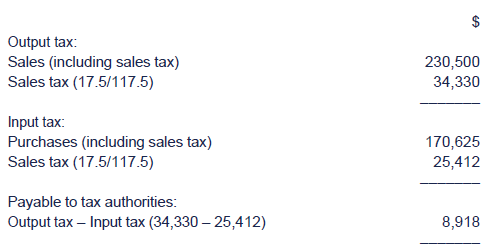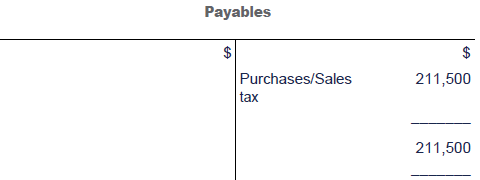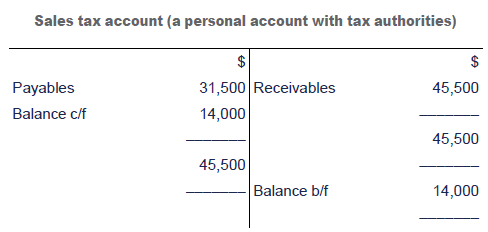Chapter 5: Sales tax
Chapter learning objectives
Upon completion of this chapter you will be able to:
- explain the general principles of the operation of a sales tax
- calculate sales tax on transactions correctly
- enter sales tax on sales and purchases into the ledger accounts.
1 Principles of sales tax
- A business that is registered for sales tax is essentially a collection agent for the government.
- Sales tax is charged on purchases (input tax) and sales (output tax).
- Sales tax is excluded from the reported sales and purchases of the business.
- Periodically the business pays the sales tax to the tax authorities.
- If output tax exceeds input tax, the business pays the excess to the tax authorities.
- If input tax exceeds output tax, the business is repaid the excess by the tax authorities.
- Sales tax is sometimes called value added tax (VAT) or goods and services tax.
- Sales tax is charged on most goods and services.
2 Calculation of sales tax
- It is common for a rate of 17.5% sales tax to be charged on the selling price.
- The following is therefore true:
Proforma

- The net selling price is the amount that the business wishes to achieve.
- The gross selling price is the price charged to customers.
- The difference is paid to the tax authorities.
Note: You should be prepared to apply any % to the proforma above.

 Illustration 1 – Calculation of sales tax
Illustration 1 – Calculation of sales tax
Calculation of sales tax
Orlando sells the following goods:
(1) to Bruno at a tax inclusive price of $470.
(2) to Cosmo at a tax exclusive price of $700.
How much sales tax is Orlando collecting on behalf of the government if the rate of sales tax is 17.5%?


 Solution
Solution
Solution
Sales tax can be calculated using the relevant percentage depending on whether the price is tax inclusive or exclusive.
Sales to Bruno (sales price tax inclusive) (17.5%/117.5%) x $470 = $70
Sales to Cosmo (sales price tax exclusive) (17.5%/100%) x $700 = $122.50
Total sales tax collected: $70 + $122.50 = $192.50


 Test your understanding 1
Test your understanding 1
Lorenzo purchases goods for $170,625 (including sales tax) and sells goods for $230,500 (including sales tax).
What amount of sales tax is ultimately payable to the tax authorities?
A $8,918
B $14,926
C $4,471
D $10,479
The sales tax rate is 17.5%.

3 Accounting entries for sales tax
The usual bookkeeping entries for purchases and sales are onlyslightly amended by sales tax, the main addition being the introductionof a sales tax account, which is a receivable or payable account withthe tax authorities.
Sales tax paid on purchases (input tax)
Dr Purchases – excluding sales tax (net cost)
Dr Sales tax (sales tax)
Cr Payables/cash – including sales tax (gross cost)
- The purchases account does not include sales tax because it is not an expense – it will be recovered.
- The payables account does include sales tax, as the supplier must be paid the full amount due.
Sales tax charged on sales (output tax)
Dr Receivables/cash – sales price including sales tax (gross selling price)
Cr Sales – sales price excluding sales tax (net selling price)
Cr Sales tax (sales tax)
- The sales account does not include sales tax because it is not income – it will have to be paid to the tax authorities.
- The receivables account does include sales tax, as the customer must pay the full amount due.
Payment of sales (output) tax
Dr Sales tax (amount paid)
Cr Cash (amount paid)
- If output tax exceeds input tax, a payment must be made to the tax authorities.
Receipt of sales (output) tax
Dr Cash (amount received)
Cr Sales tax (amount received)
- If input tax exceeds output tax, there will be a receipt from the tax authorities.

 Test your understanding 2
Test your understanding 2

Record these transactions in the ledger accounts.


 Test your understanding 3
Test your understanding 3
Valerie’s business is registered for sales tax purposes. Duringthe quarter ending 31 March 20X6, she made the following sales, all ofwhich were subject to sales tax at 17.5%:
$10,000 excluding sales tax
$7,402 including sales tax
$6,745 excluding sales tax
$11,632 including sales tax.
She also made the following purchases all of which were subject to sales tax at 17.5%:
$15,000 excluding sales tax
$12,455 including sales tax
$11,338 including sales tax
$9,870 including sales tax.
What is the balance on the sales tax account on 31 March 20X6?
A $7,639 Dr
B $1,875 Dr
C $7,639 Cr
D $1,875 Cr

Chapter summary
Test your understanding answers

 Test your understanding 1
Test your understanding 1
The correct answer is A



 Test your understanding 2
Test your understanding 2

Note that sales are recorded excluding sales tax, as this is not income for the business.

Note that purchases are recorded net of sales tax, as this is not a cost to the business.

Receivables are recorded including sales tax (the gross amount) asthe customer must pay to the business the cost of the goods plus thesales tax.

As with receivables, the payables must be recorded inclusive ofsales tax, as the business needs to pay its suppliers the gross amount.

Note: As the balance on the sales tax account represents a normaltrade liability it is included in accounts payable on the statement offinancial position.


 Test your understanding 3
Test your understanding 3
The correct answer is B


|
Created at 5/24/2012 3:31 PM by System Account
(GMT) Greenwich Mean Time : Dublin, Edinburgh, Lisbon, London
|
Last modified at 5/25/2012 12:53 PM by System Account
(GMT) Greenwich Mean Time : Dublin, Edinburgh, Lisbon, London
|
|
|
|
 |
Rating
:
|
 Ratings & Comments
(Click the stars to rate the page) Ratings & Comments
(Click the stars to rate the page)
|
 |
Tags:
|
|
|
|
|